Rabbit Ear Mites (Rabbit Ear Canker)
Rabbit Ear Infection With Psoroptes cuniculi Ear Mite.
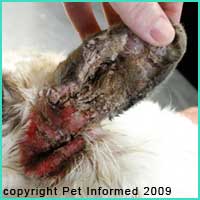 Rabbit ear mites (Psoroptes cuniculi species) are a common parasitic disease problem in both pet and commercial
rabbit populations (they probably infest the ears of wild rabbit populations also). Psoroptes rabbit ear mites are responsible for the condition known, in layman's terms, as rabbit ear canker, whereby the rabbit develops severe crusting and thick scale build-up on the inside of the ear flap (see image, right). This mite-induced ear crust causes the rabbit's ear to become intensely itchy, such that the rabbit often develops secondary sores and scabs and infections of the ear as a result of the animal's scratching and self-trauma
activities. This page contains loads of pictures and information about ear mites in rabbits
including: signs and symptoms, secondary complications of mite infestation, diagnosis of ear mite infestation
and treatment and control of the condition.
Rabbit ear mites (Psoroptes cuniculi species) are a common parasitic disease problem in both pet and commercial
rabbit populations (they probably infest the ears of wild rabbit populations also). Psoroptes rabbit ear mites are responsible for the condition known, in layman's terms, as rabbit ear canker, whereby the rabbit develops severe crusting and thick scale build-up on the inside of the ear flap (see image, right). This mite-induced ear crust causes the rabbit's ear to become intensely itchy, such that the rabbit often develops secondary sores and scabs and infections of the ear as a result of the animal's scratching and self-trauma
activities. This page contains loads of pictures and information about ear mites in rabbits
including: signs and symptoms, secondary complications of mite infestation, diagnosis of ear mite infestation
and treatment and control of the condition.

Ear Mites in Rabbits - Contents:
1) Rabbit ear infection with Psoroptes cuniculi mites - a basic summary and definition.
2) Some facts about the Psoroptes ear mite life cycle and how it survives on the host and in the environment.
3) What does rabbit ear canker look like? - Clinical signs and symptoms of ear mites in rabbits.
3a) Signs and symptoms of ear mites in rabbits.
3b) Secondary complications and side-effects (sequellae) associated with rabbit earmite infestation.
3c) Asymptomatic carriers of rabbit ear mites - Can rabbits have ear mites and show no signs?
4) How to diagnose ear mites in rabbits - Diagnosing and detecting rabbit ear mites.
5) What do ear mites look like? - Microscope pictures of ear mites in rabbits.
6) How does rabbit ear canker spread? - How did my rabbit catch ear mites?
7) Treating and curing rabbit ear canker (includes information on mite decontamination of the rabbit's living quarters).

1) Rabbit ear infection with Psoroptes cuniculi mites - a basic summary and definition.
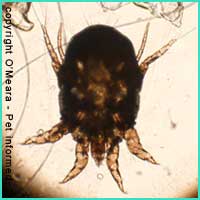 Rabbit ear mite infestation, otherwise known as rabbit ear canker, is a common ectoparasitic disease condition affecting the ears of rabbits, and related lagomorph species (e.g. hares), all around the world. Characterized by extreme crusting, scaliness, scabbiness and itchiness of
the external ear canal and pinna (the ear flap itself), the canker condition occurs when the external ear canal and pinna of the rabbit become infested by the mite species:
Psoroptes cuniculi (image on right).
Rabbit ear mite infestation, otherwise known as rabbit ear canker, is a common ectoparasitic disease condition affecting the ears of rabbits, and related lagomorph species (e.g. hares), all around the world. Characterized by extreme crusting, scaliness, scabbiness and itchiness of
the external ear canal and pinna (the ear flap itself), the canker condition occurs when the external ear canal and pinna of the rabbit become infested by the mite species:
Psoroptes cuniculi (image on right).
Being a contagious parasitic skin disease, rabbit ear mites are generally spread from rabbit to rabbit
by direct skin contact between infected and non-infected rabbits (non-infested rabbits can also contract
the mites through contact with the environment and burrows of ear-mite-infested rabbits). Consequently, mite transmission from rabbit to rabbit is generally greater in conditions whereby large numbers of rabbits are being kept in close proximity to one other (wild rabbit warrens, overcrowded hutches, rabbit rescue shelters, pet shops, rabbit breeding facilities, commercial meat or Angora rabbit farming facilities).
The rabbit ear mites initially invade the deeper regions of the rabbit's external ear canal (deep down the canal where they are not visible to the rabbit owner), rather than the clearly-visible outer pinna (ear flap) of the rabbit. Because of this, early infestations of ear mites in
rabbits are often missed by rabbit owners (the outer ear flap that the owner
can see often looks fine during these early stages and yet the ear canal is infested deeper down, out of sight of the rabbit owner). Owners may only notice occasional symptoms of ear-scratching and head-shaking by the rabbit during these early stages. As the rabbit ear mites multiply in number, the ear mite infestation expands and extends from
the ear canal of the rabbit onto the outer ear flap (pinna). At this point, the mite infestation
is generally clearly visible to the owner. The rabbit ear flap appears crusty and scabby with
large amounts of papery, grey, flaky, cellular debris clinging to the inner aspect of the pinna
(these mite-induced ear crusts are often very thick). The rabbit is often extremely irritated and itchy by this stage and scratches at its head and ears frequently, often to the point of self-trauma and making its skin bleed.
Left untreated, the mite-infested ears can become so traumatised by the rabbit that secondary bacterial infections
of the skin can set in, resulting in the rabbit becoming feverish (febrile), lethargic
and sick. Such infection can sometimes invade the middle and inner ear sections of the rabbit
producing severe neurological signs (head tilt, loss of balance, wobbliness of the gait)
and even fatal meningitis. In advanced cases, the Psoroptes cuniculi rabbit ear mites can leave the
ears altogether and expand their populations across the rabbit's body (in particular
the head, neck and belly and the skin regions around the anus and genitals and the legs and feet), resulting in severe, generalized body scratching and widespread skin redness, trauma-induced hair loss, widespread scabbing (skin sores) and dermatitis.
Mite infestations tend to be more severe and symptomatic
in situations of high-stress, which suggests that the immune system of the rabbit has
a big part to play in managing the severity of a mite infestation. The immune system
tends to be suppressed under conditions of severe internal stress (e.g. physical illness, lactation, pregnancy, growth, concurrent disease, malnutrition) and external stress (e.g. over-crowding, unhygienic living conditions, bullying, inadequate provision of nutrients, extremes
of heat and cold) and, consequently, mite infestations tend to be more severe when such stressors exist. For example, it is common to see infestations of rabbit ear mites explode
in pregnant or lactating doe rabbits and in over-crowded rabbit populations.
Not all rabbits with ear mites show symptoms. Low numbers
of rabbit ear mites can occasionally be found in the ears of normal rabbits. These non-symptomatic, infested animals, termed
carrier animals, provide a dangerous source of mite transmission and infestation for other more-susceptible individuals
in a rabbit population.
Author's Note: Psoroptes cuniculi does not only infest rabbits and their related species. The mites will occasionally infest the ears of horses, mules, donkeys, sheep, goats, antelope and deer, producing mild to
marked symptoms of ear irritation and ear crusting and discharge. Although generally restricted to
the ears and the skin immediately around the ears, Psoroptes cuniculi infestations can sometimes
become severe and generalised (involve other regions of the body) in individual livestock hosts. The goats and horses (and other livestock species mentioned) probably contract the mites by grazing upon pasture that is home to populations of ear-mite-infested wild rabbits (the affected rabbits drop mites and mite eggs into the livestock animals' pasture environment), however, direct
animal-to-animal (e.g. horse-to-horse and goat-to-goat ...) skin contact may also help to spread the mites around.
Author's Note: Psoroptes cuniculi is not the species of mite responsible for causing "sheep scab"
or "Australian itch" in sheep. Sheep scab is a notifiable (reportable) parasitic disease caused by a different species of Psoroptes called Psoroptes ovis. Sheep scab is a nasty Psoroptes ovis
mite infestation of the sheep's body skin, which causes the sheep to scratch excessively all-over,
resulting in severe, self-inflicted trauma to the sheep's skin, secondary skin infections and excessive scab-formation. The itching and scab-formation ruins the quality of the sheep's wool, resulting in economic losses for wool producers. Australian itch
or itch mite is a parasitic disease caused by a much different species of mite called Psorergates ovis. Like sheep scab, Psorergates ovis
mite infestation also infests the body skin and causes the infested sheep to scratch excessively
all-over. This results in severe, self-inflicted trauma to the sheep's skin, secondary skin infections and wool-matting. The itching, wool-tearing and wool-matting ruins the quality of the sheep's wool, resulting in economic losses for wool producers. Neither mite is contracted by the sheep from contact
with rabbits or rabbit-contaminated pasture (although, as a side note, laboratory studies have found that P. cuniculi
and P. ovis can cross-mate to produce viable offspring so, in theory, maybe some rabbit ear mites could find
their way onto a sheep to become part of a reproducing P. ovis population ...).

2) Some facts about the Psoroptes cuniculi ear mite life cycle and how it survives on the host and in the environment.
Transmission of ear mites in rabbits:
Being a contagious parasitic skin disease, rabbit ear mites are generally spread from rabbit to rabbit
by direct skin contact between infected and non-infected rabbits. The rabbit ear mites are transferred
when the mite-infected skin (e.g. the ears) of one rabbit brushes up against the skin and fur of
another rabbit. The mites simply crawl from one animal to the next. Consequently, mite transmission from rabbit to rabbit tends to be much greater in living conditions whereby large numbers of rabbits are housed in very close proximity to one other (e.g. wild rabbit warrens, overcrowded hutches, rabbit rescue shelters, pet shops, rabbit breeding facilities, commercial meat or Angora rabbit farming facilities).
When mite-infested rabbits shake or scratch their ears, flakes of mite-infested crust and scale rain down from
the ears and into the rabbit's environment. These falling flakes and crusts contain live mites
and their eggs. Because rabbit ear mites can survive away from the host animal for days to weeks
(up to 3 weeks, depending on environmental humidity and temperature conditions), the environment
of the mite-infested rabbit (hutches, burrows, pasture, feeding sources) should also be considered
an important source of mite-infestation for non-infected animals. Non-infested rabbits can contract ear
mites from direct contact with the environment and burrows inhabited by ear-mite-infested rabbits.
For this reason, when treating ear mites in rabbits, it is important to also decontaminate
the environment that the rabbit is living in so that it does not become a source of mite
reinfestation for the newly-treated bunnies (see section 7 on treatment and environmental mite management).
How the rabbit ear mite lives and feeds (how it produces symptoms of disease):
Psoroptes cuniculi rabbit ear mites do not burrow down into the skin epidermis
like certain other mange mite species do, but instead remain upon the surface of
the skin. The mites pierce right through the rabbit's skin with their mouthparts in order to feed upon
the rabbit's lymphatic fluids (lymph).
As the mite feeds, its body produces and secretes waste products like feces
and mucus, which are highly proteinaceous and antigenic (allergenic) to the rabbit's skin. The rabbit's immune system reacts against the mite faeces and mucous, resulting in a moderate to severe inflammatory reaction occurring within the rabbit's ear canal.
This inflammatory reaction results in redness, heat, swelling and itchiness of the ear canal skin
(the rabbit starts scratching and shaking its ears because of this inflammatory pain and itchiness), as
well as the oozing of inflammatory fluids (serum) and white blood cells onto the surface of the irritated skin. The inflammatory serum ooze engulfs and entraps the white blood cells, mite feces, mites and
surface epithelial cells on the surface of the skin and the whole lot dries out, producing the classic thick, grayish crusts and scale seen in this condition. In summary: it is not the feeding activities of the mites per se that creates most of the signs and symptoms (itching, scratching, pain and so on) associated with this canker condition, but the overwhelmingly aggressive immune system response made
by the rabbit towards the foreign proteins secreted by these ear parasites (i.e. essentially, the symptoms are the result of an allergic hypersensitivity reaction towards the mites' feces and mucus).
Subsequent generations of rabbit ear mites tend to take up their feeding positions at the edges of the crusts, causing yet
more inflammation and scab formation to occur, and thus the entire infestation of mites and their associated crust
tends to spread and expand outwards, eventually leaving the dark depths of the external ear canal
(where the infestation tends to begin) and spreading out across the pinna.
The life cycle of ear mites in rabbits:
There are five stages to the Psoroptes rabbit ear mite life cycle. These are
the egg, larva, protonymph, tritonymph and adult. Within 4 days of being laid
by an adult mite, the mite egg hatches to release a larval mite (larva). The larval mite feeds
and grows, eventually becoming too big for its confining exoskeleton. At this point, the larva sheds its exoskeleton, emerging from it as a slightly larger stage called a protonymph
(both larva and protonymph stages have only 6 legs). Again, the protonymph mite stage feeds
and grows, eventually becoming too big for its confining exoskeleton. At this point, the protonymph sheds its exoskeleton, emerging from it as a slightly larger, eight-legged stage called a tritonymph.
The tritonymph mite stage feeds and grows, once again eventually becoming too big for its confining exoskeleton. At this point, the tritonymph sheds its exoskeleton, emerging from it as an adult mite (eight-legged also). The adult mite feeds and lays more eggs. The entire life cycle
from egg to adult to egg takes place in 3 weeks.
Author's note: Some texts and webpages suggest that there are only 4 life cycle
stages of Psoroptes cuniculi (the tritonymph is often omitted), however,
I have chosen to say that there are five stages based on an Entomology journal article (reference 9),
which studied this very question in some depth.
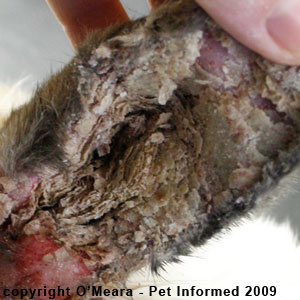
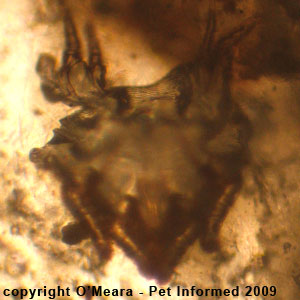
Rabbit ear mites in rabbits picture 1: This rabbit ear is severely infested with Psoroptes cuniculi ear mites.
The thick, greyish scale and crusting seen in this picture is a mixture of serum, inflammatory cells, mites, mite feces, shed exoskeletons and skin flakes all matted and dried together as a result
of the rabbit's severe inflammatory response towards the mite parasites.
Rabbit ear mites in rabbits photo 2: I found this amongst the scale and crust viewed under
the microscope. It is an 8-legged mite exoskeleton (minus the head), which became caught up and
bound within the scale and ear debris. I am not 100% certain as to whether this is just the remains of a deceased adult mite (an exoskeleton left behind after everything else decomposed away)
or if it could be the shed exoskeleton of a tritonymph moving up to the adult stage.

3a) What does rabbit ear canker look like? - Clinical signs and symptoms of ear mites in rabbits.
Ear mites in rabbits - How ear mites produce symptoms of itching and scratching and crust-formation in rabbits' ears:
Psoroptes cuniculi rabbit ear mites do not burrow down into the keratinised epidermal layers of the rabbit's skin like certain other species of mange mites do. They instead live out their lives (feeding and breeding)
on the surface of the rabbit's skin. The mites survive by piercing the rabbit's ear skin with their needle-like
mouthparts and feeding upon the rabbit's lymphatic fluids (lymph).
As the mites feed, their bodies secrete various protein-containing waste products (like feces
and mucus), which are highly antigenic (immune-system-stimulating) and allergenic (allergy-response-triggering)
to the rabbit's immune system. The rabbit's immune system reacts violently against the mite faeces and mucous present on the aural skin surface, resulting in a moderate to severe inflammatory reaction occurring within the rabbit's ear canal.
This inflammatory reaction results in redness, heat, swelling and itchiness of the ear canal skin, which causes the rabbit to become irritated and to start scratching at and shaking its ears. The scratching
and self-trauma that results damages and abrades the rabbit's ear skin even more, resulting in yet more inflammation and itchiness and scratching - a vicious cycle.
In addition to the heat, swelling, redness and itchiness of the skin, the severe inflammatory
reaction also results in the oozing of inflammatory fluids (serum) and white blood cells (immune system cells) onto the surface of the irritated skin. The inflammatory serum ooze engulfs and entraps the white blood cells, mite feces, mites and surface epithelial cells on the surface of the skin and the whole lot dries out, producing the classic thick, grayish-brown crusts and scale seen in this condition
(see ear mites in rabbits images below for visual reference). Subsequent generations of mites (the offspring of those who were not entrapped within the concrete-like serum crust) tend to take up their feeding positions on the skin at the edges of the crusts, causing yet more inflammation and scab formation to occur. In this way, the entire infestation of mites and their associated crusting and skin-inflammation responses tends to spread and expand outwards, eventually leaving the dark depths of the external ear canal due to a lack of space (where the infestation tends to begin) and spreading outwards across the ear pinna and body skin.
Signs and symptoms of ear mites in rabbits - How rabbit ear mite infestations tend to progress and worsen:
Rabbit ear mites tend to initially invade the deeper regions of the rabbit's external ear canal
(deep down the ear canal where they are not visible to the rabbit owner), rather than the clearly-visible outer pinna (ear flap) of the rabbit. Because rabbit owners can not
see mite infestations that are hidden deep within the dark recesses of the rabbit ear canal, early infestations of ear mites in rabbits are often missed by rabbit owners. Owners may only notice very occasional symptoms of ear-scratching and head-shaking by the rabbit during these early stages of ear mite infestation. Subtle hair thinning or loss of hair around the edges of the pinnas (ear flaps) may also be recognized. Early mite infestation may involve only one ear or both ears of the rabbit (note - as the mite parasite population expands and progresses, both ears will generally become infested). Veterinarians looking down into the ear canals of symptomatic rabbits may be able to see the first crusts and scabs (and sometimes
even live, crawling mites), which are characteristic of this condition, allowing for early diagnosis to occur.
If the early stages of mite infestation (above paragraph) are not recognised and treated, the mite infestation will progress. As the ear mites multiply in number, producing more and more
crust and scale, the ear mite infestation and its associated inflammatory process expands and grows, eventually extending from the passage-like ear canal of the rabbit and out onto the outer ear flap (pinna). At this point, the ear mite infestation is generally clearly visible and obvious to the rabbit owner. With moderate to advanced ear mite infestations, the rabbit ear flap appears crusty and scabby with large quantities of thick, papery, grayish, flaky, cellular debris (crusts) clinging to the inner aspect of the pinna. These crusts can
be so thick and heavy that the infected ears flop down with the weight of them. The rabbit is often extremely irritated and itchy by this stage and scratches and chews at its head and ears frequently, often to the point of self-trauma (making the skin bleed).
The rabbit will often shake its head, flicking its ears about to relieve the irritation.
Left untreated, the ears can become so traumatised by the rabbit that secondary bacterial infections
of the damaged skin can set in, resulting in the rabbit becoming feverish (pyrexic), lethargic (sleepy)
and sick. Allowed to progress, bacterial infection can sometimes invade the middle and inner compartments of the rabbit's ear/s producing severe neurological signs (e.g. head tilt, loss of balance, incoordination of the gait) and even a fatal meningitis.
It has been known for advanced, long-term cases of ear mites to result in the loss of the rabbit's
ear flaps (loss of the pinnas). The ears are essentially eaten away over time by the ravenous mites (or by the self-traumatizing rabbit - rabbits will sometimes chew off their own ears!).
In very advanced cases of ear mites in rabbits, the Psoroptes cuniculi mites will expand their populations across the rabbit's body, infesting in particular the head, neck and belly of the rabbit as well as the skin regions around the anus and genitals and the legs and feet. This expanded, body-wide mite infestation results in severe, generalised body scratching with widespread skin redness; patchy, trauma-induced hairloss; widespread skin scabbing (numerous skin sores) and extensive dermatitis and secondary bacterial skin infection.
Author's note: Mite infestations tend to be more severe and more widespread throughout a rabbit population when that population of animals is living under conditions of high-stress (especially long-term stress). This suggests that, even though the sensitive immune system of the rabbit is responsible for many
of the clinical signs and symptoms seen in rabbit ear mite infestations (e.g. inflammation, crusting, pain, itching), it still has a big role to play in managing and reducing the severity of an ear mite infestation. The rabbit immune system tends to be suppressed (weakened) when the rabbit is exposed to conditions of severe, prolonged internal stress (e.g. physical illness, lactation, pregnancy, growth, concurrent disease, malnutrition) and/or external stress (e.g. over-crowding, unhygienic living conditions, bullying, inadequate provision of nutrients, extremes
of heat and cold) and, consequently, mite infestations tend to be more severe when
when such stressors exist. For example, it is very common to see ear mite infestations explode
in pregnant or lactating female rabbits and in over-crowded rabbit populations.
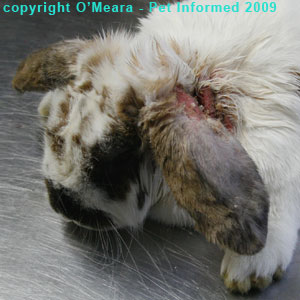
Ear mites in rabbits picture 3: This rabbit's ears are so severely infested with
rabbit ear canker and heavy ear crusts (see following images) that they droop
with the weight of them. (Pet Informed thanks the owners of this rabbit for allowing us to take these pictures - this bunny went on to make a full recovery).
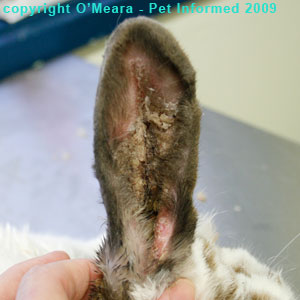
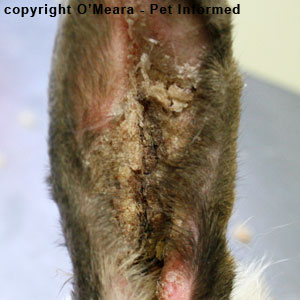
Ear mites in rabbits pictures 4 and 5: These are images of the inside aspect of the right ear of the rabbit in the above photo (image 3). The ear canal and the underside of the ear flap (pinna)
are caked with thick, grayish-brown, paper-like crust and scale - a classic case of
Psoroptes cuniculi infestation. Where the scale and crusts have flaked away, the exposed
skin of the ear is reddish-pink (the result of the skin's inflammatory reaction towards the
mites).
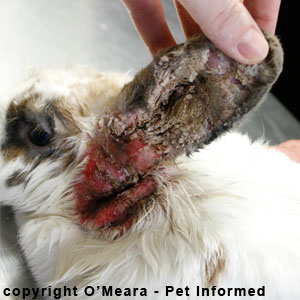
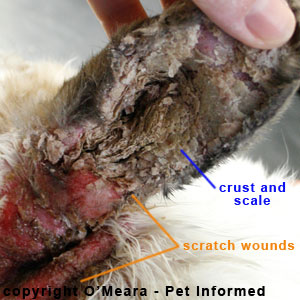
Ear mites in rabbits photographs 6 and 7: These are images of the inside aspect of the left ear of the rabbit in the above photo (rabbit ear mites image 3). The ear canal and the underside of the ear flap (pinna) are caked with extra-thick, grayish-brown, paper-like crust and scale - a classic case of
Psoroptes cuniculi infestation. Where the scale and crusts have flaked away, the exposed
skin of the ear is reddish-pink (the result of the skin's inflammatory reaction towards the
mites) and dotted with sores (the result of the rabbit's scratching and self-trauma activities).
At the base of the left ear, the rabbit's skin was red raw and bleeding. This rabbit had scratched its skin so badly
that it had literally torn the skin away. The skin was infected with secondary bacteria, making the rabbit feverish and unwell. Treatment of this rabbit involved not only treating the mite infestation itself, but the secondary bacterial ear infection that accompanied it.
Author's note: This ear was far more severely affected than the right ear. It is not uncommon for one ear to be more severely infested with ear mites than the other.
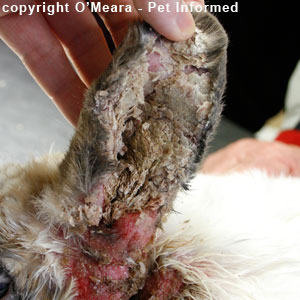

Ear mites in rabbits photographs 8 and 9: More photos of the left ear. The
extra-thick, gray, paper-like flakes clinging to the underside of the ear pinna and plugging the
ear canal itself are clearly visible. Attempting to pick these flakes off or "scrub them off"
is very painful for the rabbit and results in bleeding of the skin. Despite their thickness, these crusty flakes will often drop off within 10 - 14 days of an appropriate systemic mite treatment being given.

3b) Secondary complications and side-effects (sequellae) associated with rabbit earmite infestation.
There are a number of secondary complications that can result from severe ear mite infestation.
A. Secondary bacterial skin infection:
Ear mites in rabbits can become so itchy and irritating that the rabbit literally scratches
its ears and also the skin around the base of its ears, cheeks and neck to the point of ulceration and bleeding. The scratched skin can become so ulcerated and traumatised by the rabbit that secondary bacterial infections (often Streptococcus and Staphylococcus bacterial species)
will start to grow within the moist, ulcerated sores. The skin around the bacteria-infected sores will become red, hot, and swollen and sore to touch (the rabbit resists the sores being handled or cleaned)
and the sores may weep a smelly (rotten-smelling), creamy, yellow to green coloured, white-blood-cell-rich fluid
commonly known as pus. The rabbit's lymph nodes (especially those under the jaw and along the neck, which drain
lymph from the face and ears) may become enlarged, painful and swollen. In severe cases, these bacterial infections can become so nasty that the rabbit becomes feverish and unwell. It may sleep more than normal, appear weak and even go off its food and water.
Treatment involves the administration of supportive care (fluids and hospitalization etcetera for very sick rabbits), antibiotics and wound cleansing to control the bacterial infection in addition to the miticide treatments administered to kill the ear mites.
B. Secondary bacterial skin infection with associated abscessation:
In severe cases of secondary bacterial skin infection, bacterial organisms can become seeded
deep within the layers of the skin and subcutis (the connective tissues under the skin); even
traveling along the draining lymphatics and becoming lodged in the regional draining lymph nodes. When these bacterial "seeds" lodge within these enclosed tissue regions, they multiply in number and
are, subsequently, attacked by millions of white blood cell soldiers called neutrophils. The neutrophils (which are the main cellular component of pus) attack the bacterial invaders en masse, not only destroying the bacteria that they are designed to kill, but the rabbit's own body tissues in the immediate vicinity of the bacteria. The body tissues around the bacteria break down upon exposure to the neutrophil attack toxins (cytolysins) and the neutrophils accumulate in the space left behind, resulting in the formation of a pocket of creamy, yellow-white or pinky-brown pus and bacteria termed an abscess. Such abscesses may set up in the traumatised skin around the rabbit's neck or the base of the ears
or within the draining lymph nodes of the jaw and neck. These abscesses initially appear to rabbit owners as painful, hot swellings under the skin, which often grow significantly in size before bursting out through the skin and releasing copious amount of purulent fluid (pus). Rabbits with abscess pockets tend to be quite unwell. They are often feverish (pyrexic), lethargic (sleepy) and sick and many will go off their food and water.
Treatment involves bursting and flushing the abscess in order to achieve removal and drainage of the accumulated pus and bacteria. Follow-up treatment with systemic antibiotics and wound flushing is often needed to control the bacteria and cure the condition (in addition to the treatments administered to kill the mites).
C. Secondary bacterial ear infection with middle and inner ear involvement +/- neurological signs:
Bacterial infections that occur secondary to ear mite infestations can sometimes track
deep into the rabbit's ear canal, resulting in a nasty bacterial ear canal infection
termed otitis externa. Provided that these bacterial organisms remain located only in the outer ear canal of the rabbit (i.e. the external ear canal situated on the outermost aspect of the rabbit's ear drum), systemic antibiotics and topical antibiotic ear medications (in addition to the mite killing treatments) will often be enough to resolve the problem.
Occasionally, however, bacterial organisms will manage to eat their way through the ear drum of ear mite infested rabbits, resulting in a nasty bacterial infection of the middle
and inner sanctums of the rabbit's ear (termed the middle ear and inner ear, respectively).
These middle-ear and inner-ear bacterial infections (termed, respectively, otitis media and otitis interna)
are not only very difficult to treat and control (not to mention painful for the rabbit!), but they can result in some serious complications of their own. Damage to the middle and/or inner ear mechanisms can result in deafness
of the ear. Damage to the inner ear mechanisms, in particular the vestibular apparatus
of the inner ear (a series of specialized fluid canals located deep within the inner ear, which are responsible for
normal balance), can result in the rabbit showing severe signs of incoordination and neurological
dysfunction. The rabbit will appear off-balance, falling frequently, often with its head twisted around (a severe head tilt) to one side. Termed torticollis (see the rabbit image below),
the twisting of the head and neck can be so severe that the rabbit can not stand up at all
without falling over. Thus-afflicted rabbits are often very distressed and will thrash about trying to get
up, which is most distressing for the owner to watch and poses a risk of the rabbit traumatising its eyes
or injuring its spine. In the most severe situations, bacterial infection of the inner ear can even track
upwards along the vestibulocochlear nerves and into the rabbit's brain, resulting in
severe bacterial meningitis and/or brain abscessation.
Treatment of otitis media/interna requires aggressive systemic and topical antibiotic therapies and sometimes even surgical flushing, debridement and drainage of the middle ear compartment (the tympanic bulla). Because rabbit pus is usually excessively thick and cheesy in consistency, it is often difficult to
achieve adequate drainage and removal of pus and bacteria located deep within a rabbit's middle and inner ear compartments. It is even harder to treat an abscess pocket that has seeded into the brain. The prognosis
for a rabbit who develops bacterial otitis interna/media, particularly one who is showing neurological signs (head tilt, torticollis), should be considered guarded. Even if they do
initially respond favourably to antibiotic treatments, these cases will often regress once the
antibiotic therapy has ceased. The prognosis for brain abscesses and meningitis is very poor in rabbits.
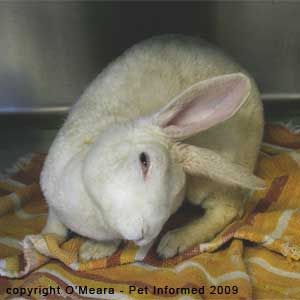
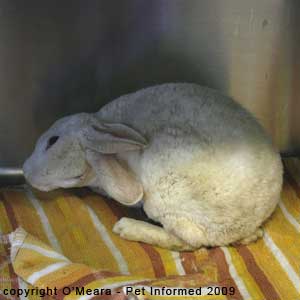
Ear mites in rabbits pictures 10 and 11: This is an image of a rabbit with
a severe otitis media (middle ear) and otitis interna (inner ear) bacterial infection. The rabbit's vestibular apparatus (the balance mechanism in the ear) was damaged
by bacteria, resulting in the rabbit being off balance and uncoordinated in its movements. The rabbit fell often when it moved and so generally elected to remain as still as possible (it tended to occupy the one spot within its cage). The rabbit's head was twisted around to the side
(the severe head tilt is termed torticollis) as part of this neurological dysfunction. This rabbit was more fortunate than some, given that it could actually stand upright and eat
from a bowl. Some rabbits with severe vestibular disease can not get up nor coordinate their movements
enough to eat or drink.
Author's note: This particular rabbit did not have ear mites. It had a Pasteurella or Bordetella
bacteria infection, which had tracked from its respiratory system into its
middle ear by way of the auditory canal (eustachian tube) at the back of the throat.
The head-tilt appearance, however, is identical to that which would be seen in a severe ear-mite induced
otitis media-externa, which is why I have included the photograph.
D. Secondary bacterial ear infection with maggots ("fly strike" or myiasis):
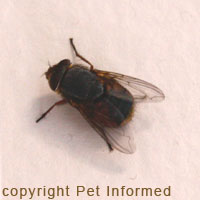 When damaged skin becomes moist and infected and smelly, it becomes attractive to large, maggot-laying flies called blowflies. The term "blow-fly" is a general term encompassing several species of fly, which lay carnivorous maggots onto dead meat (e.g. deceased corpses)
or onto the infected, rotting flesh of live animals. Open, infected sores, abscess pockets and moist infected ear canals, associated with severe ear mite infestations, are perfect locations for blow fly maggots to feed and grow and thus rabbits with ear mite infestations should always be considered at risk of developing secondary "fly strike" (maggot infestation).
When it occurs, flystrike (correct term: myiasis) is very irritating and painful for the rabbit and, if severe, can result in the death of the rabbit.
When damaged skin becomes moist and infected and smelly, it becomes attractive to large, maggot-laying flies called blowflies. The term "blow-fly" is a general term encompassing several species of fly, which lay carnivorous maggots onto dead meat (e.g. deceased corpses)
or onto the infected, rotting flesh of live animals. Open, infected sores, abscess pockets and moist infected ear canals, associated with severe ear mite infestations, are perfect locations for blow fly maggots to feed and grow and thus rabbits with ear mite infestations should always be considered at risk of developing secondary "fly strike" (maggot infestation).
When it occurs, flystrike (correct term: myiasis) is very irritating and painful for the rabbit and, if severe, can result in the death of the rabbit.
Treatment of flystrike requires aggressive systemic antibiotic therapies and aggressive flushing, debridement and draining of the "struck" or
"blown" wounds in order to remove all of the invading maggots. Insecticides will often be used to flush the maggot-ridden wounds in order to kill all of the fly larvae present.
E. Aural Hematoma:
Ear mites in rabbits can become so itchy and irritating that the rabbit spends much of its
time shaking its head about violently in order to relieve the biting itch. When the rabbit shakes its
head, throwing its ears around, the blood vessels inside of those ears become exposed to massive centrifugal
forces (G forces) and also to impact forces (which result from the ears whacking up against
the rabbit's neck and cage bars). The blood vessels within the rabbit's ear pinnas can rupture as
a result of these forces, resulting in the formation of a very large blood pocket within the ear flap (a big, soft, swollen ear flap) called an aural hematoma. Aural hematomas are not painful or dangerous to the rabbit, but they do look unsightly
to pet owners and tend to make the ear flop with their weight.
Treatment of aural hematomas often involves surgical
drainage of the blood pocket (hematoma) and also treatment of the underlying
ear disease (i.e. the ear mites).

3c) Asymptomatic carriers of rabbit ear mites - Can rabbits have ear mites and show no signs?
The answer is yes. Not all rabbits with ear mites show symptoms. Low numbers
of Psoroptes mites can occasionally be found in the ear canals of apparently-normal rabbits. Although
these rabbit individuals are seemingly unharmed by the mites that they carry, these non-symptomatic, mite-infested animals, termed carrier animals, do provide a dangerous source of mite transmission and infestation for other more-susceptible individuals in a rabbit population.
The existence of an ear mite carrier state suggests that one or both of two things might be going on:
a) the carrier animal is not allergic to the mites' excrement - as stated
in section 2, much of the itching and skin-crusting associated with ear mites in rabbits
is the result of the animal's own immune system reacting aggressively against the allergenic feces and mucus
that are secreted by the feeding mites. It is essentially an allergic-type response. An
individual rabbit might present as a mite carrier (show no symptoms of irritation, despite having a mite infestation)
because its immune system and skin happens to tolerate (not be allergic or reactive towards) the
mites' allergenic mucus and excreta, resulting in no symptoms of itchiness, crusting or dermatitis occurring.
b) the carrier rabbit's immune system has reached a state of neutral equilibrium with the mites - in many different types of parasitic infestations, the
host animal's immune system attacks and kills the parasites so aggressively that the remaining parasites are forced to go into a quiet, almost dormant, state if they are to avoid
being attacked any more. The "dormant" parasites' feeding and breeding activities slow radically
and the immune system, detecting few parasites and/or parasite secretions to attack, backs-off
and reduces its inflammatory aggression (and thus the clinical symptoms of disease
are also reduced). In this way, in a kind of cease-fire, the immune system and the surviving mite populations reach a balance and the animal is left with a small, but constant, population of mites and a low-grade, quiescent immune system response
and thus no symptoms of disease - i.e. a carrier state.
Dealing with carriers:
Because carrier animals may exist in any population of rabbits, it should be assumed that
non-symptomatic animals in a population afflicted with ear mite parasites are carrying the mites also.
Left untreated, these non-symptomatic animals pose a major source of mite reinfestation for the rest
of the rabbit population. Consequently, when treating a group of rabbits for ear mites, rabbit owners should remember to treat all of the animals in the population for the
mites (including the carriers), not just the ones showing the ear symptoms.
Can non-symptomatic carriers revert back to showing signs of ear mites?
The answer is yes. Even though, from the above points (a and b), it probably seems as though the animal's immune system, and not the mites, is responsible for
all of the problems and clinical signs shown by the rabbit, this is not wholly true. The ear mites can and do
produce clinical signs of their own making. They bite the rabbit's skin, producing
trauma to the skin (this places the skin at risk of secondary bacterial infection),
and, in large numbers, their feces and mucus secretions may even irritate or burn (scald)
the surface of skin, producing irritant damage. If the immune system did not react against
the mites in order to reduce mite numbers, the numbers of mites would explode and the rabbit
would still end up developing significant ear and skin symptoms (just the biting irritation of the hundreds of mites alone would result in the rabbit scratching) and an increased risk of secondary bacterial infection.
Mite infestations tend to be more severe and more widespread throughout a rabbit population when that population of animals is living under conditions of high-stress (especially long-term, chronic stress). This supports the above view that, even though the immune system of the rabbit is responsible for many
of the clinical signs and symptoms seen in rabbit ear mite infestations (e.g. inflammation, crusting, pain, itching), it still has a big role to play in managing the severity of an ear mite infestation. The rabbit immune system tends to be suppressed (weakened) when the rabbit is exposed to conditions of severe internal stress (e.g. physical illness, lactation, pregnancy, growth, concurrent disease, malnutrition) and external stress (e.g. over-crowding, unhygienic living conditions, bullying, inadequate provision of nutrients, extremes
of heat and cold) and, consequently, mite infestations tend to be more severe when
when such stressors exist. For example, it is very common to see ear mite infestations explode
in pregnant or lactating rabbits and in over-crowded rabbit populations.
A non-symptomatic carrier rabbit could easily become symptomatic for ear mites (start showing signs of disease)
if its immune system somehow became unable to hold down (suppress) the population of mites present within its ears
(i.e. if the immune system waned). This could happen if the rabbit
became immune suppressed. Stress, other illnesses, sudden weight loss, malnutrition, unhygienic living conditions, extremes of cold or heat, bullying, immune suppressant drugs and a raft of other immunosuppressant
factors could cause such an effect on a carrier animal.
Likewise, a symptomatic rabbit could eventually become a carrier rabbit (immune to the effects of the parasites) if it was supported with antiparasitic medications and if its immune system was improved through better health, living conditions, good diet and the like.

4) How to diagnose ear mites in rabbits - Diagnosing and detecting rabbit ear mites.
Ear mites in rabbits are generally diagnosed in vet clinics using a step-by-step
diagnostic approach that culminates in the visualisation of ear mites under a microscope
(diagnosis confirmed) and/or in the administration of a successful treatment trial.
A) Clinical signs and physical examination:
Never underestimate the value of a thorough physical examination. Just by examining
the rabbit itself, most vets will normally have a pretty fair idea of whether or not rabbit ear
mites could be at fault.
Ear mites should always be suspected or at least tested for in a rabbit showing one or more of the following signs:
- ear scratching (one or both ears)
- ear chewing (one or both ears)
- self trauma (scratching trauma) to the skin of the neck, cheek or base of the ears
- head and ear shaking
- thinning of the fur along the margins of the ears (one or both ears)
- crust and scab build-up inside of the ear canals (one or both ears)
- thick crust and scale build-up on the pinna flaps themselves (one or both ears)
- recurrent bacterial ear infections (can be secondary to mites)
- head tilt - torticollis - and an unbalanced gait.

 Ear mites in rabbits pictures 12 and 13:
Ear mites in rabbits pictures 12 and 13: This is almost a no-brainer diagnosis wise. Once a rabbit's ear or ears becomes this severe, the diagnosis is almost always ear mites
(
Psoroptes cuniculi). Not too many other pathogens cause this degree of crusting
and flake-formation in a bunny ear.
B) Otoscope examination:
If the mite-suspected rabbit is symptomatic, but has minimal outward evidence of ear mite infestation (i.e. the rabbit is scratching its ears and shaking its head, but its ears appear visibly clean or have only minor hair-thinning present on the ear edges), then the vet will need to look down the rabbit's ear canals with a viewer called an otoscope. As mentioned
previously, rabbit ear mite infestations generally start deep within the ear canals
of the rabbit so symptoms of ear irritation (head shaking, ear scratching and so on)
will often appear well before signs of crusting and skin redness become visible on the outer pinna.
The otoscope allows the vet to see deep into the external ear canal of the rabbit
and perhaps visualize the first signs of scaling and crusting, which are typical of
rabbit ear mite infestations. Very lucky vets may even spot live mites moving around
within the ear canal (they look like white dots with legs), which is sure proof of
diagnosis. Failure to spot moving mites, however, does not mean that ear mites aren't
present (they often hide underneath the margins of the scabs and crusts within the ear
canal, invisible to the spying vet). It just means that the vet will need to move onto
the next stage of diagnostics (looking at the ear crusts under the microscope) in order to confirm
the ear mite diagnosis.
If the ears are badly encrusted (like images 12 and 13, above) then the otoscope
probably will not go down the rabbit's ear canal. The otoscope step can probably
be skipped in these cases and the vet can move onto the next stage of diagnostics (looking at the crusts
and scabs under the microscope) in order to confirm the ear mite diagnosis.
C) Microscope examination of the rabbit ear crust:

The visualisation of
Psoroptes cuniculi rabbit ear mites (image right) under the microscope
generally provides definitive proof of an ear mite infestation in a rabbit (remembering
though that non-symptomatic mite carriers may test positive also). Spotting one or, preferably, more
mites under the microscope certainly confirms the presence of a
mite infestation. Such a finding would definitely warrant treating for.
In order to diagnose the ear mites, the veterinarian picks off some of the crust and scab from the rabbit's ear/s and examines it under the microscope. Generally
the ear crust is submerged in a drop of paraffin oil and covered over with a microscope
cover slip to facilitate the viewing of the sample.
Getting the best samples:
Samples can be collected from the inside of the rabbit's ear canal (if ear mite infestations
are early) or from the outer pinna of the rabbit (if ear mite infestations
are advanced). Because ear mite populations tend to move outwards as the ear crust accumulates
and because the mites tend to live under the outer edges of the crusts, best results are
generally achieved by sampling and viewing the crusts on the very edges of the lesions.
Dissolving the ear crust samples in KOH (potassium hydroxide) solution just
prior to viewing them is also very helpful. The KOH solution breaks down and dissolves
the thick crusts of the scab, leaving only the mites behind. This makes mites that were
formerly hidden deep within the scabby material more easily visualised. To be quite
honest though, rabbit ear mites are generally pretty easy to find even without the
use of KOH solution.
D) Treatment trial with ivermectin injection:
Sometimes, despite all of the best attempts at sampling and viewing the ear crusts, the rabbit ear mites remain elusive and unseen and therefore undiagnosed. In such cases
where the vet is particularly convinced that ear mites are at fault, but just can't find them, a treatment trial using ivermectin injectable solution or selamectin spot-on (see treatment section 7 for doses)
is perfectly appropriate. If the rabbit's ears improve radically following the administration
of the medication, then an assumption of mite infestation is quite fine to make.
An ivermectin treatment trial can also help the veterinarian to determine whether any mites found during an ear work-up are actually causing the clinical signs seen in the rabbit. If the clinical signs (itching, head shaking) resolve with the administration of
ivermectin, then the mites probably were at fault. If the clinical signs do not resolve,
then the mites were either completely coincidental (not at fault) or only a contributing factor
to the overall ear condition.
 5) What do rabbit ear mites look like? - Microscope pictures of rabbit ear mites.
5) What do rabbit ear mites look like? - Microscope pictures of rabbit ear mites.
All mites (and ticks) belong the
Order: Acarina, one of the many orders of parasitic and non-parasitic
organisms that are grouped under the general
Class: Arachnida (the arachnids). This class includes
the spiders, ticks and scorpions. As such, mites generally have tiny (often microscopic) bodies that do not appear to be all that well segmented into the discrete head, thorax and abdomen sections commonly seen in insects (unlike insects, mites tend to have a non-segmented, solid body with legs in the middle and a head stuck on one end). Adult and tritonymph mite stages have eight legs (four pairs), whereas larval and protonymph stages have six legs (three pairs).
There are five Suborders of mites in Order Acarina, four of which are of veterinary significance. I don't
need to go into detail about the five parasitic mite suborders in this section, suffice to say that every species of mite has been grouped into one of the four suborders on the basis of similarities in certain body structures to other mites in the suborder.
Psoroptes cuniculi belongs to the mite
Suborder: Astigmata. This suborder includes:
the dog, cat and ferret ear mites (
Otodectes); the dog, cat and guinea pig mange mites (
Sarcoptes scabei, Notoedres
cati and
Trixacarus caviae, respectively); the bird scaly leg and beak mites (
Knemidocoptes species);
various sheep, horse and cattle skin mites (
Chorioptes) and various air sac mites of poultry. All of these Astigmata
mites share some common features:
a) their bodies are rounded in shape and not long and worm-like like the mites of Suborder Brachypoda (
Demodex) are;
b) they have no hard plate on their backs (termed a scutum) like some other mite suborders and tick suborders do;
c) they have no air-holes in their skin (termed stigmata) through which to breathe;
d) they have no tarsal claws (no claws on the end of their feet) and
e) some or all of their legs bear tarsal suckers called
caruncles (suckers on the ends of their feet).
To make matters more complicated, within the Suborder: Astigmata there are two distinct mite groupings
or
Families called, respectively, Family Psoroptidae and Family Sarcoptidae. I don't need to go into detail about the two astigmatid mite families in this section, suffice to say that every species of mite in the Suborder: Astigmata has been subgrouped into one of the two Families on the basis of similarities in certain body structures to the other mites in the same Family. Mites in
Family Psoroptidae (includes
Psoroptes,
Chorioptes and
Otodectes species) do not burrow into their host's skin and the rearmost legs of the female mites (leg pairs 3 and 4) protrude outwards beyond the margins of the mite's body. In contrast,
mites in Family Sarcoptidae (includes
Sarcoptes,
Trixacarus and
Notoedres
species) do burrow deeply into their host's skin and the rearmost legs of the female mites
(leg pairs 3 and 4) do not protrude outwards beyond the margins of the mite's body.
To cut a long story short, Psoroptes cuniculi ear mites in rabbits belong to the following:
Class Arachnida; Order Acarina; Suborder Astigmata; Family Psoroptidae; Genus Psoroptes and Species
Psoroptes cuniculi. Phew!
As such, they have the following lifestyle and body shape characteristics, many of which can be recognised when viewing and identifying them under a microscope:
a) adult and tritonymph stages have 8 legs;
b) larva and protonymph stages have 6 legs;
c) their bodies are not distinctly-segmented into the discrete head, thorax and abdomen sections commonly seen in insects - i.e. they look like a body with a head;
d) their bodies are rounded and not long and worm-like like those mites of the suborder Brachypoda (Demodex) are;
e) they have no hard plate on their backs (termed a scutum) like some other mite suborders and tick suborders do;
f) they have no air-holes in their skin (termed stigmata) through which to breathe;
g) they have no tarsal claws (no claws on the end of their feet);
h) some or all of their legs have tarsal suckers (suckers on the ends of their feet);
i) they do not burrow into their host's skin (they live on the skin surface);
j) the rearmost legs of the female mites (leg pairs 3 and 4) protrude outwards beyond the margins of the mite's body and
k)
Psoroptes can be further differentiated from
Otodectes and
Chorioptes (same Family)
by the unique features of their legs.
Psoroptes legs are long and the pretarsi of their legs have long, 3-segmented pedicels (see photos below, where all has been made clear).
Otodectes and
Chorioptes legs have short, unsegmented pedicels.
Author's note: the last images in this section are of the dog ear mite:
Otodectes cynotis
and the guinea pig mange mite:
Trixacarus caviae, showing how differences
in body shape and leg structure can be used in the identification of a mite species.
Pictures of rabbit ear mites under the microscope:
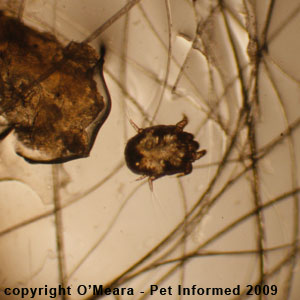
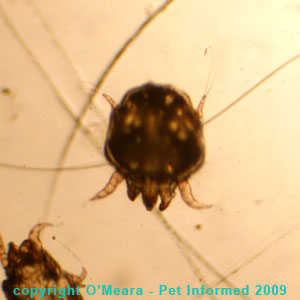
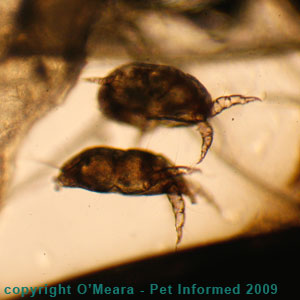
Rabbit ear mites in rabbits pictures 14 and 15: These first two images contain pictures of
live rabbit ear mites as seen under the microscope. This is how live ear mites appear when you
view them from the top. The mites' front legs appear bent and at odd angles in these
pictures because the photos were taken of the mites whilst they were still alive and actively paddling through the microscope oil. Rabbit ear mites are easily spotted
in fresh samples because they swim about.
Rabbit ear mites in rabbits picture 16: This is how live rabbit ear mites appear when you
view them from the side.
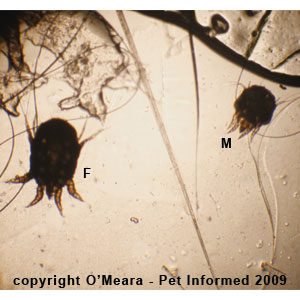
Rabbit ear mites in rabbits photograph 17: This is a photo of a pair of rabbit ear mites, a
male mite and a female mite. The female mite (left) is much larger than the male (right). This great
size difference between the males and females is commonly seen in many arachnid species.
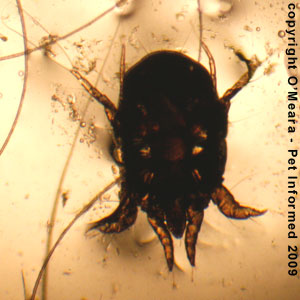
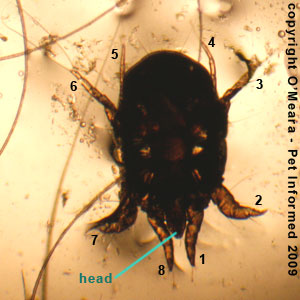
Rabbit ear mites in rabbits pictures 18 and 19: This is a photo of a female rabbit ear mite.
- The eight legs have been identified and numbered (image 19), so we know that she is an arachnid and that she is an adult (or tritonymph).
- Being microscopic in size, she is much too small to be a spider, tick or scorpion, so she must be a mite (one of the four Suborders of parasitic mite).
- Her body is not long and worm-like, so she is not of the Suborder: Brachypoda (Demodex), thus ruling out one of the four Suborders.
- Although not easy to tell from these images, her body has no scutum (back plate) or airholes (stigmata),
so we know that she is not of the other two mite Suborders: Mesostigmata and Prostigmata.
- Her feet have tarsal suckers (termed caruncles), which also rules her out of the Suborder Prostigmata.
- As a result of these findings, we know that she must be of the Suborder: Astigmata.
Furthermore:
- Her hind legs (legs 3, 4, 5 and 6) protrude well beyond the margins of her body.
- She was found living on the surface of the rabbit's skin.
- As a result of these findings, we know that she must be of the Family: Psoroptidae.
Furthermore:
- Her legs have long, 3-segmented pedicels (with caruncles) hanging off the ends of them (you can just make them out on legs 8, 1 and 2).
- She was found living on a rabbit's skin.
- As a result of these findings, we know that she must be of the Genus Psoroptes, Psoroptes cuniculi being the main species of the rabbit.
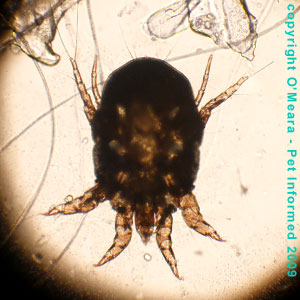
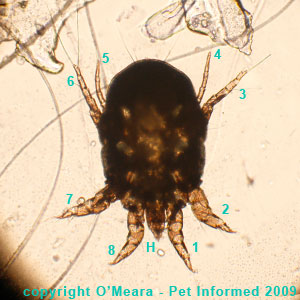
Rabbit ear mites photos 20 and 21: This is the same photo of the female rabbit ear mite,
taken at a lighter exposure. This exposure makes the mite's leg pedicels and caruncles impossible to see,
but shows up her body structures very nicely.
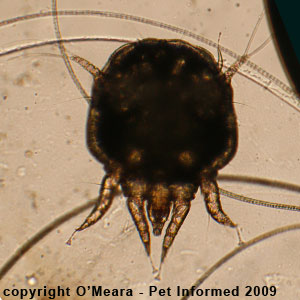
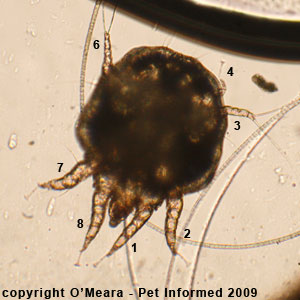
Rabbit ear mites pictures 22 and 23: This is a photo of a male rabbit ear mite. Male rabbit ear mites are
smaller and more circle-shaped than female mites and their innermost rear legs (legs 4 and 5) barely reach much beyond
the margins of their bodies. Sometimes (as in leg 5 of this picture - not labeled because it is unseen) the innermost rear legs of the male mite remain curled under its body and out of sight. This can cause
viewers to incorrectly think that the mite is a larva or a protonymph or that it is
not a mite at all!
Author's note: The long, segmented pedicels and caruncles on the ends of the mite's legs are clearly visible
in these images.
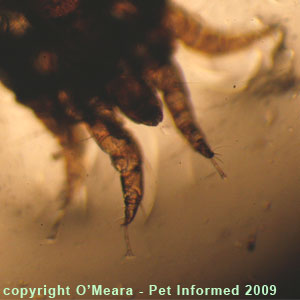
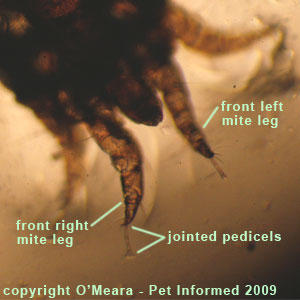
Rabbit ear mites pictures 24 and 25: These are magnified views of the front legs of
a Psoroptes cuniculi rabbit ear mite, showing the characteristic, long, segmented (jointed) pedicels
and caruncles hanging off the tips of the mite's limbs. A mite must have these pretarsi (pedicel and caruncle combination) if it is to be called a Psoroptes cuniculi mite.
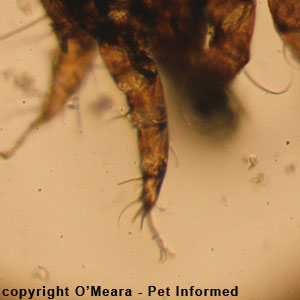
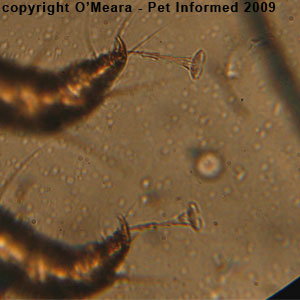
Rabbit ear mites pictures 26 and 27: These are some more magnified views of the front legs of
a Psoroptes cuniculi rabbit ear mite, showing the characteristic, long, segmented (jointed) pedicels
and caruncles hanging from the tips of the mite's limbs.
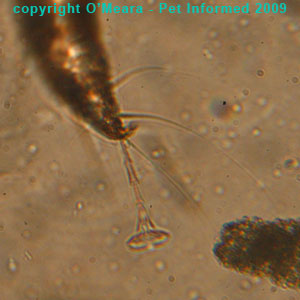
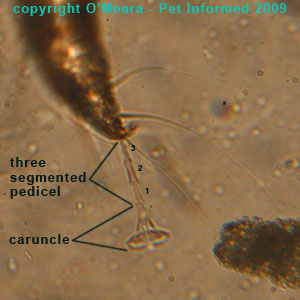
Rabbit ear mites pictures 28 and 29: These are lovely close-up images of the pedicels and caruncles. You can clearly see the three segments (labeled in rabbit ear mite image 29) making up the pedicel
as well as the cup-like sucker or caruncle located at the tip of the foot.
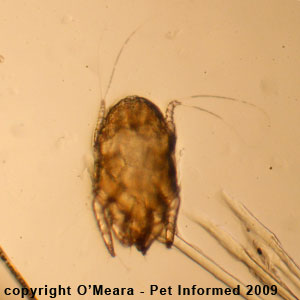
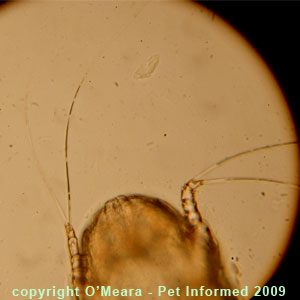
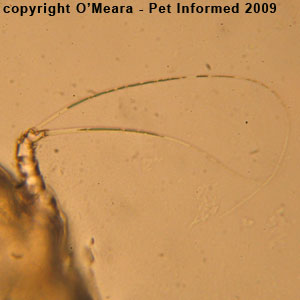
Rabbit ear mites pictures 30, 31 and 32: These are images of a deceased rabbit ear mite,
which is why it appears less detailed in its features and different in colouration.
I have included these images because they show off nicely the two long hairs that are
present on rear legs 3 and 6 of the rabbit ear mite. Both male and female mites seem to
have these long hairs in the place of pedicels on limbs 3 and 6, though they tend to be much
longer in the female mite than the male. Note that legs 4 and 5 are not visible in these images (they are most
likely curled up under the rabbit ear mite's body).
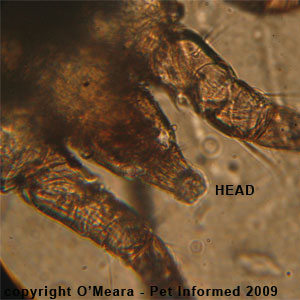
Ear mites in rabbits picture 33: The head of the rabbit ear mite.

Rabbit ear mites picture 34: I found this object in amongst the scale and crust, viewed under
the microscope. It is an 8-legged mite exoskeleton (minus the head), which has become caught up and
bound within the scale and ear debris of the rabbit's ear crusts. I am not 100% certain as to whether this is just the remains of a deceased adult mite (an exoskeleton left behind after everything else decomposed away)
or if it could be the shed exoskeleton of a tritonymph moving up to the adult stage.
Pictures of other parasite mites under the microscope:
I have included this small pictorial section to show you just how important pedicel anatomy
of the mite can be to achieving a diagnosis of a mite species.
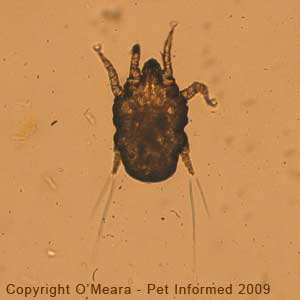
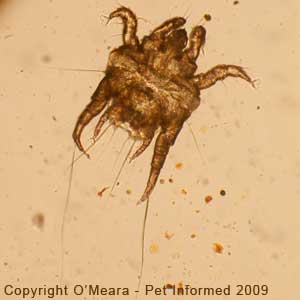
Ear mites in dogs pictures 35 and 36: These are images of some dog ear mites
(Otodectes cynotis) taken under the microscope. They look very similar in appearance
to Psoroptes mites because they are of the same Family as the rabbit ear mite: Psoroptidae.
Their feet and pedicels are, however, much different to those of Psoroptes cuniculi (see next images).
Author's note: All images that were taken of the Otodectes mite seen in picture 35 revealed only
six legs. This makes it likely that this mite is a larva or protonymph stage of the Otodectes mite life cycle. The mite could be an adult male with its back legs (4 and 5) curled underneath it, but it is hard to be certain.
Author's note: The mite in image 36 is an adult female Otodectes mite. She has
eight legs and the rearmost of these legs protrude well beyond the margins of her body (i.e. typical of
Family Psoroptidae).
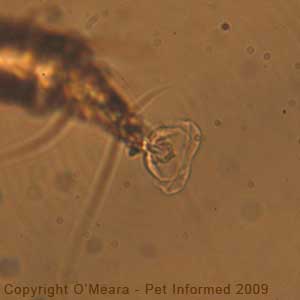
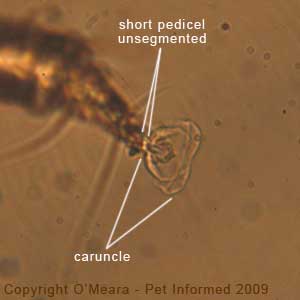
Ear mites in dogs pictures 37 and 38: These are lovely close-up images of the pedicels
and caruncles of the dog or cat (or ferret) ear mite, Otodectes. Unlike the long, segmented
pedicels of the rabbit ear mite, the dog ear mite has an extremely short, unsegmented
pedicel stalk (it is so small as to be almost non-existent). It does, however, have a large, cup-like sucker or caruncle located at the tip of its foot.
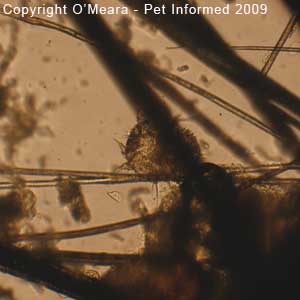
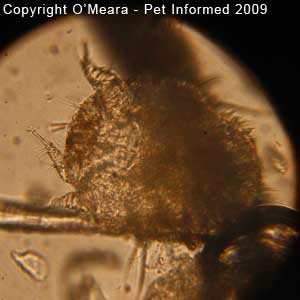
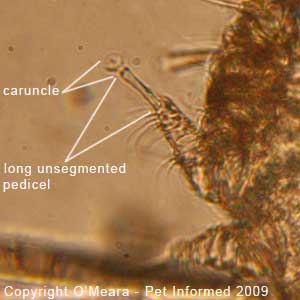
Guinea pig mites pictures 39 and 40: Guinea pig mange mites tend to be difficult to
get good photos of and these images are no exception. They do however show some
important features of the guinea pig mange mite (Trixacarus caviae)
and the mite Family Sarcoptidae.
Basically, any mite of the Family Sarcoptidae pretty much looks like a hairy,
round ball with four legs (legs 1, 2, 7 and 8) sticking out of the front of its body (this is essentially what can be seen in picture 40). Unlike the situation previously demonstrated with the female Psoroptidae mites (Psoroptes and Otodectes), the four rear legs of the female Sarcoptidae mites
do not protrude beyond the margins of the body.
Guinea pig mites picture 41: The pedicels of the guinea pig mange mites are different
to those of the rabbit ear mites as well. Unlike the long, segmented
pedicels of the rabbit ear mite, the guinea pig skin mite has a long pedicel that is unsegmented
(it is just a long, straight rod). The guinea pig skin mite does have a large, cup-like sucker or caruncle located at the tip of the pedicel just like that of the rabbit ear mite.

6) How does rabbit ear canker spread? - How did my rabbit catch ear mites?
Being a contagious parasitic skin disease, rabbit ear mites are generally transferred from rabbit to rabbit
by direct skin contact between infected and non-infected rabbits. The rabbit ear mites are transferred
when the mite-infested skin (e.g. the ears) of one rabbit brushes up against the skin and fur of
another rabbit. The mites simply crawl from one animal to the next, resulting in infestation. Consequently, mite transmission from rabbit to rabbit tends to be much greater in living conditions whereby large numbers of rabbits are kept in very close proximity to one other (e.g. wild rabbit warrens, overcrowded hutches, rabbit rescue shelters, pet shops, rabbit breeding facilities, commercial meat or Angora rabbit farming facilities).
When mite-infested rabbits shake or scratch their ears, flakes of mite-infested crust and scale rain down from
the infested ears and into the rabbit's environment. These falling flakes and crusts contain live rabbit ear mites
and their eggs. Because rabbit ear mites can survive away from the host animal for days to weeks
(up to 3 weeks, depending on environmental humidity and temperature conditions), the environment
of the mite-infested rabbit (hutches, cages, burrows, pasture, feeding sources) should also be considered
an important source of mite-infestation for non-infected and recently-treated animals. Non-infested rabbits can contract ear
mites from direct skin contact with the environment and burrows of ear-mite-infested rabbits
(even if the infested rabbits are no longer living in them). For this reason, when treating ear mites in rabbits, it is important to also decontaminate
the environment that the rabbit is living in so that it does not become a source of mite
reinfestation for the recently-treated bunnies (see section 7 on treatment and environmental mite management). Resting the rabbit environment (e.g. rabbit hutch) and leaving it free of all rabbits for at least 4 weeks (adult rabbit ear mites can survive up to 3 weeks off the rabbit host) should ensure that the environment becomes free of parasitic ear mites.
Author's note: Allowing pet rabbits to wander and play in public areas (e.g. parks, reserves, farms), even
on leads and harnesses, can expose them to ear mites from the environment, should that environment be home to populations of mite-infested wild rabbits.
It is also possible for you, the rabbit owner, to transmit ear mites from rabbit to rabbit via your hands and clothes. Petting and handling rabbits with rabbit ear mites, even if you don't actually know that they have ear mites, can result in rabbit ear mites crawling onto your skin and clothing. These mites should not harm you in any way, but they can pass from your skin or clothes onto the coat and ears of any other rabbits
(including your own pets) that you subsequently handle, rendering them infested. In order to avoid bringing ear mites (and other infectious diseases) home to your own pet rabbits, you should refrain from handling
rabbits and hares whose background and health status is unknown. In particular, be very
cautious of handling unknown stray and wild rabbits and rabbits in pet shops and shelters.

7) Treating and curing rabbit ear canker (includes information on mite decontamination of the rabbit's living quarters).
There are several aspects to treating and preventing ear mite infestations in rabbits, which should all be
taken into consideration. These are as follows:
a) Treating the ear mite infestation - should I use systemic medications or topical therapies or both?
b) Cleaning the wounds - is it good to clean the crusts and scabs off?
c) Treating any secondary ear mite complications - antibiotics, flystrike treatments and so on.
d) Treating and removing the rabbit ear mites from the animal's environment - environmental decontamination and
e) Preventing future rabbit ear mite outbreaks if repeated mite exposure is expected.
A) Treating the rabbit ear mite infestation:
There are two main treatment options available to us for treating ear mite infestations
in rabbits: systemic treatments using oral, injectable or dermally absorbed (e.g. spot-on) antiparasitic drugs and topical treatments (applying antiparasitic medications directly
to the infected ears of the rabbit).
OPTION 1 - Systemic medications (e.g. ivermectin, selamectin):
Systemic treatments seem to be favored over topical treatments as a means of getting rid
of ear mites in rabbits because of their less frequent dosing, their ease of administration and their
overall better results. Systemic treatment refers to medications that are given either orally, by injection or by dermal, "spot-on" application of the drug to the rabbit's skin and which
reach and treat the entire skin area of the rabbit by traveling to the skin via the animal's blood stream.
- Systemic medications reach the entire skin of the rabbit, not just the ears, eradicating mite populations that are present on other regions of the rabbit's body;
- Systemic medications are not painful to give (except for momentary injection pain if a needle is used to administer the drugs);
- Systemic medications are not messy and, except for the "spot-on" formulations, leave no residues on the skin;
- Systemic medications are easy to give and kill rabbit ear mites very effectively, even in the presence of thick crusts;
- Systemic medications require less frequent dosing than topical medications do (up to 2-weekly dosing).
On the flip side, because systemic medications can not simply be washed away from the rabbit once given, should
there be an adverse reaction or side effect (e.g. an allergic reaction or toxic reaction) this can potentially be much more severe and more difficult to treat with the systemic mite therapies
than with the topicals. Fortunately, however, adverse reactions are not all that commonly encountered with most of the systemic mite treatments that we use, provided
that they are dosed correctly.
Important author's note: Certain systemic mite treatments may leave toxic drug
residues behind in the meat of rabbits that are being kept for meat-production purposes. It may
not be legal for meat-producing rabbits to receive certain systemic mite therapies and, if such treatment is legal, important meat withholding periods may need to be met. Ask your vet or local meat inspector about the rules and the potential for drug residues if you are planning on treating rabbits that are being kept for human consumption purposes.
Important author's note: Certain systemic mite treatments may be toxic to
unborn rabbit babies (fetuses) and produce birth deformities. I would not advise
using systemically-absorbed mite treatments in pregnant animals without first talking to a vet. If your rabbit is pregnant and has rabbit ear mites, ask your vet what the best course of action is
for your circumstances.
Dosing:
Ivermectin (Ivomec) can be given by subcutaneous injection at a dose rate of 0.4mg/kg once every 2 weeks for three treatments.
Alternatively, Selamectin (Revolution) at 18mg/kg can be given topically (spot-on) once a month to control ear mites [ref 3, 11].
Oral moxidectin has also been reported to work (I am not sure of the dose so ask your vet). Because of toxicity concerns, moxidectin must never be given to rabbits by the injectable route.
Ear crusts should start to fall off within 10-14 days of treatment.
Important author's note: Remember that carrier animals could exist in your population. Don't forget to treat all of your rabbits, not just the symptomatic ones! Treat all rabbits that have been in contact with the mite infested rabbit and/or its environment.
OPTION 2 - Topical medications (ear drops and powders):
Topical treatments (ear drops, powders and oils) are rarely used to control ear mites
in rabbits except in very specific circumstances (i.e. when systemic treatments are unavailable or when some other factor precludes their use - e.g. meat producing animals, pregnant rabbits, a history of previous allergic or adverse reactions to systemic mite meds and so on). I almost never use topical treatments
to control ear mites in rabbits because the systemic medications work so well.
Topical treatment refers to medications that are applied directly (topically) onto the skin in regions of active skin mite infestation.
Applied as various formulations, including: liquids, drops, rinses, sprays, powders and creams, topical
medications are designed to kill rabbit ear mites by making direct contact with the mites. If the active ingredient does not make contact with the mites directly, the rabbit ear mites will not die.
There are some major problems and difficulties associated with using topical ear mite therapies:
- Topical medications do not reach the entire skin surface area of the rabbit, unless they are deliberately
and directly applied to every region of the animal's body (which is seldom practical and can result in toxicity). Consequently, even if they do manage to successfully treat the mites located inside of the rabbit's ears, topical therapies may not eradicate mite populations that are present on other regions of the rabbit's body (this results in rapid reinfestation);
- Topical medications are painful to apply (rabbits with sore ears resent them);
- Topical medications are messy and leave residues on the skin;
- Topical medications are not easy to give because most rabbits try to avoid having their painful ears touched;
- Topical medications can not penetrate through thick crusts and scabs and so ear mites living deep within the rabbit's ear canals may well remain alive simply because the treatment never reached them;
- In order for topical medications to reach and kill all of the mites, the rabbit's ears may need to be cleaned of crusts, which can be a very painful procedure for the animal.
- Topical medications may not be able to enter ear canals that have become inflamed and narrowed and, therefore, they will make no contact with the ear mites located deep within the rabbit's ear canals;
- Topical medications require more frequent dosing (up to twice-daily) than systemic medications do;
- Topical medications may be more expensive than systemic medications;
- Some topical medications may stain the wool of wool producing Angora rabbits, resulting in production losses;
On the flip side, because topical medications can simply be washed away from the rabbit if
there is an adverse reaction (e.g. an allergic reaction or toxic reaction), adverse side effects
associated with topical medicants can potentially be managed and treated much more rapidly and completely than those reactions associated with systemic therapies. Likewise, some topical therapies do not get absorbed into the rabbit's body at all, making them much
safer to use in potentially pregnant animals and in animals being kept for meat production
purposes.
There are several topical options for treating ear mites in rabbits:
Mineral oil: Instill 1-2ml of mineral oil into each ear canal and massage the ear canals
thoroughly for 30-60 seconds to disperse the oil throughout the crust. This process may need to be repeated twice daily for several weeks to reach all of the ear mites and achieve the right effect.
Flea powder: a rabbit-safe flea powder (applied to the ears and canals) may be an option to help treat ear mites
in rabbits, but it is unlikely to get down a densely-crusted ear canal very well. A dry powder is also likely to hurt and irritate the ears further if it makes contact with open wounds and sores.
B) Cleaning the wounds - is it good to clean the crusts and scabs off?
If systemic mite treatments are being administered, there is generally no need to scrub off the ear crusts. This just puts the rabbit through unnecessary pain. The crusts will generally just
fall off on their own.
If topical mite treatments are being administered, then crusts and scabs may need to be cleaned away
first to allow the topical therapies to reach all regions of the rabbit's ear canal. This can be very painful for
the rabbit and should ideally be performed under sedation or anaesthesia.
C) Treating secondary complications of ear mites - antibiotics, flystrike treatments etc.
If the ear mite infested rabbit has secondary bacterial skin infections as a result of its mite-induced skin
disease, then the vet may need to dispense systemic and/or topical antibiotic medicines to treat the problem.
Bacterial abscesses of the skin will require surgical drainage as may aural hematomas.
Treatment of flystrike (maggots) requires that aggressive systemic antibiotic therapies be given
and that aggressive surgical flushing, debridement and draining of the "struck" or
"blown" wounds be performed in order to remove all of the invading maggots. Insecticides will often be used to flush the maggot-ridden wounds in order to kill any of the remaining fly larvae that are present.
Subjectively, I have also found that flushing maggot infested wounds with a chlorhexidine scrub solution helps to get rid of them (I have literally watched maggots flee
from wounds that have been flushed with chlorhex - they don't seem to like it).
See section 3b - secondary complications of ear mite infestation - for more information
about the secondary complications of ear mites in rabbits and the various treatment options.
D) Treating the mites in the animal's environment - environmental decontamination.
When mite-infested rabbits scratch or shake their ears, flakes of mite-infested crust and scale shower down from
the infected ears and into the rabbit's environment. These flakes and crusts contain live mites
and their eggs. Because rabbit ear mites can survive away from the host animal for days to weeks
(
up to 3 weeks, depending on environmental humidity and temperature conditions), the environment
of the mite-infested rabbit (hutches, cages, burrows, pasture, feeding sources) should also be considered
an important source of mite re-infestation for non-infected and recently-treated animals. Rabbits can contract
mites from direct skin contact with the environment and burrows of ear-mite-infested rabbits
(even if the infested rabbits are no longer living in them). For this reason, when treating ear mites in rabbits, it is important to also decontaminate the environment that the rabbit is living in so that it does not become a major source of mite reinfestation for the freshly treated or non-infested bunny.
There are several options for removing rabbit ear mites from the infested rabbit's environment:
1. Throw out unnecessary litter, bedding and fodder: Fine bedding materials like shredded paper, straw, hay and wood-chips have a very large surface area, making them almost impossible to chemically decontaminate and render free of rabbit ear mites and their eggs.
The mites simply hide out within fine cracks in the bedding (e.g. cracks in the woodchips),
waiting until any chemical cleaner or disinfectant has gone away before re-emerging. Physically removing all such potentially-contaminated litter and bedding from the rabbit's environment and replacing it with fresh, clean bedding materials is far more likely to remove the mites than trying to clean it is.
I have a similar opinion of towels and other forms of cloth bedding. It
is possible to steam clean
and machine wash cloth bedding materials and towels and blankets to the point of being mite-free, but unless they
are particularly valuable, costly kinds of bedding it may not be worth the effort. Replacing
the bedding completely (i.e. buying new towels or blankets for your rabbit) is less effort on your part
and is much more likely to give you a guarantee of mite-free comfort for your rabbit.
Likewise, wood blocks, logs and many other forms of rabbit chewing-entertainment commonly placed
into a rabbit's environment do have a high surface area (cracks in the wood and so on) and so tend to harbour mite infestations very effectively. If such items are present and are not valuable, it is my recommendation that these also be discarded and replaced.
2. Rest the rabbit's environment: Resting the rabbit environment (e.g. rabbit hutch) and leaving it free of all rabbits for at least 4-6 weeks (adult rabbit ear mites can survive up to 3 weeks off the rabbit host) should ensure that the environment becomes free of parasitic ear mites.
This is a nice, chemical-free, safe way of ridding ear mites from a rabbit's environment.
Be careful to ensure that the environment you are resting is not being visited by a constant
population of potentially-infested wild rabbits or hares. No amount of environmental rest will
keep rabbit ear mites out of an environment (e.g. a lawn or pasture) if infested animals are constantly visiting
your home and dropping mite-infested scale into the environment.
3. Treat the rabbit's environment: Rabbit-safe insecticide products are available that will effectively decontaminate rabbit ear mite infestations
in a rabbit's environment. These products are commonly available as spray-on or rinse
products.
Although some of these chemical products can be used in the presence of rabbits
(i.e. applied to the environment whilst the rabbit is still dwelling within that environment), it is always safer for the rabbit if it is removed from the environment whilst insecticide
treatment is taking place. Just because the product isn't "toxic" doesn't mean that
the rabbit won't react allergically or respiratorially towards the sprays and aerosols
and fumes given off by the insecticide product. Allowing the treated environment to
rest for a few days (or as many rabbit-free days or weeks as the product packet recommends) before returning the rabbit to the environment is always a good idea and ensures that
rabbit exposure to insecticide residues is minimized.
Important: Always read the label carefully before using any insecticide chemical
on a rabbit or its environment. Some insecticides are toxic to rabbits and should never be placed
in a rabbit's environment (use only rabbit-safe ones). Some insecticides are toxic to people and
should only be applied in a well-ventilated area, using gloves and a face-mask (and eye protection)
for protection. Some insecticides must be given time to disperse (reducing residues) before a rabbit
can be allowed back into the treated environment. Some insecticides are toxic to waterways
and natural environments and so need to be disposed of carefully.
4. Consider completely replacing the rabbit's environment: This is an expensive (and often unnecessary) option and is generally only used by those
rabbit owners who have a persistent and recurrent problem with ear mites in their rabbits. Certain kinds of hutches (especially hutches made out of porous woods) are very hard to clean and very hard to keep ear mites and other diseases out of once they become established
(note that resting any hutch for 6 weeks is usually effective at killing off ear mites).
Some owners may find that ear mites in rabbits and other rabbit diseases are easier to manage
in their rabbit population if they purchase hutches that are easier to keep clean and which are less prone to harboring disease. Hutch materials like plastic, slate, concrete, tile and metal (including wire - though it
can be more work to clean wire than solid metal) can often be easier to clean, disinfect and manage than
materials like dirt, wood and lawn, but do come with their set of own problems, which must be weighed up (e.g. the rabbit might chew up a plastic hutch;
wire flooring might cause pressure sores on the rabbit's feet; metal and plastic trap heat and
might cause overheating of the rabbit or skin burns).
Certainly, the location of the hutch and its accessibility to wild animal vectors of rabbit
ear mites may be something that could be changed, resulting in a positive result.
If your rabbit's hutch (or environment) is frequently visited by wild animal populations
(especially rabbits and hares), then ear mite recurrence is very likely. Buying a new hutch
or modifying an old hutch to prevent these wild mite-carriers from coming into contact with
your pets can be a useful way of achieving ongoing environmental mite control (i.e.
control after the environment has been insecticide treated or rested) and preventing ear mites in rabbits from recurring.
How I treat ear mites in rabbits and their environment:
This is not the only way to manage ear mites in rabbits and their environments,
but it is a basic outline as to the way I tend to go about it. I tend to combine the
treatment of the rabbit with the treatment and resting of the rabbit's environment so that
both become clean and mite-free at the same time.
1. Separate the rabbit from its intended living environment (i.e. from its hutch, rabbit cage):
Whilst the infested rabbit is being medically treated for ear mites (e.g. the 6 week course of ivermectin), it could be dropping infectious mites and mite eggs into its local environment. In order to prevent
this environmental mite contamination from continuing (giving the hutch a chance to rest), I tend to remove the rabbit from its intended permanent living quarters (e.g. the hutch) and treat it elsewhere for 6 weeks. This gives the hutch 6 weeks to rest - ample time
for the rabbit ear mites and their eggs to die off.
2. Place the rabbit into a temporary, easy-clean environment for the duration of its medical treatment (about 6 weeks):
What I tend to do in these situations is get the rabbit's owner to keep the infested rabbit/s
in a temporary, easy-to-clean, large-sized box or crate for the duration of the rabbit ear mite treatment course. The box or crate is usually made of hard plastic (non-chewable) or metal (or wire) and lined in clean, disposable bedding
(e.g. straw, shredded paper). The box or crate is kept inside of the owner's house (or shed, so long as it stays cool)
so that the rabbit does not overheat in the plastic or metal enclosure (metal and plastic crates
hold the sun's heat and do not allow much breeze to waft through them, putting the rabbit
at risk of overheating).
Alternatively, if a large box or crate seems a bit too confining and a little too Alcatraz for you, then
a large children's playpen, set up inside of the house on a tiled, stone or otherwise easy-to-clean
floor is just as good.
The rabbit is kept in this new easy-clean enclosure for 6 weeks and receives its
medical treatment at the same time (e.g. ivermectin injections 2-weekly for 3 doses).
The rabbit's bedding is changed daily and the easy-clean enclosure is vacuumed
and disinfectant-scrubbed and dried-thoroughly every day as well (usually at the same time
as the bedding is being changed). This vigilant cleaning helps to keep mite numbers to
a minimum within the new enclosure and any rabbit ear mites that do make it back onto the rabbit are usually killed by the medications that the rabbit is receiving.
3. Clean and treat and modify the rabbit's intended living quarters (e.g. hutch) as needed while the rabbit is away:
While the rabbit is in its new, temporary accommodation receiving treatment, the rabbit's intended living environment (e.g. its hutch) is also being rested (6 weeks) such that it should
be free of rabbit ear mites by the time the rabbit patient returns.
Pet owners can choose to just let the hutch sit and become mite-free on its own or
they can use the time to more-actively remove the rabbit ear mites and modify and improve the
hutch design. The rabbit owner should clean out the hutch while the rabbit is away, removing all disposable bedding and fodder and disinfecting and scrubbing the hutch from
top to bottom. Owners who wish to treat the hutch with insecticides should be able to
treat the rabbit's hutch with rabbit-safe insecticides several times during the 6-week period, thus ensuring that the hutch is completely mite-free and residue-free before the rabbit returns.
More enterprising owners can use the 6-week period to modify their hutch for future
disease and parasite control. They can remove all of the wood from the hutch (this
removes an important site of disease harboring). They can elevate the hutch from the ground
so that mite-carrying wild rabbits can not make contact with the pet rabbits. They can set up other means of preventing wild rabbits from coming into contact with the freshly-treated rabbits.
E) Preventing future rabbit ear mite outbreaks if repeated mite exposure is expected.
There are ways that future rabbit ear mite infestations can be prevented:
Mineral oil:
Once the ears have been treated for mites and have returned to normal (no crusts or scabs), a few drops of mineral oil placed into each ear weekly can help to prevent new rabbit ear mite infestations from establishing inside of the ears.
Revolution (selamectin):
Monthly revolution treatment (18mg/kg) applied prophylactically
(or at the first signs of ear symptoms) is a good way of preventing ear mites in rabbits.
Reduce stress:
Ear mite populations in rabbits tend to explode in the presence of stress. Making every attempt
to reduce the stressors impacting on your rabbit's life can go a big way towards reducing
the presence of mites and other diseases in your rabbit pets. Ensuring that your rabbits
are: provided with adequate nutrition; provided with balanced nutrition; provided with
hygienic, clean living conditions; not over-crowded; not being bullied by other rabbits;
not exposed to extremes of heat and cold; vaccinated against disease; wormed
and treated early for any other medical or disease conditions that arise can help to keep
rabbit ear mite numbers low.
Avoid overcrowding:
Rabbit ear mites tend to spread more quickly through a rabbit population when that
population is overcrowded. Avoiding overcrowding reduces mite transmission.
Avoid situations that result in mite transmission:
Mites can be transmitted from wild rabbits and hares and their environments (pastures, fields, reserves)
to pet rabbits. Mite infestation can be avoided if wild lagomorphs (rabbits, hares)
are not permitted to make contact with your own pet rabbits. Not allowing your rabbits to
make contact with wild-animal-exposed pastures and environments can also help to reduce the risk of
rabbit ear mites being picked up from the environment.
Domesticated rabbits of unknown background and disease status (e.g. rabbits from shelters, pet shops, breeding facilities) can also transmit ear mites to pet rabbits by direct rabbit-to-rabbit contact. Not allowing your rabbits to make contact with unknown rabbits and their environments can also reduce the risk of rabbit ear mites being picked up by your rabbit.
It is also possible for you, the rabbit owner, to transmit ear mites from rabbit to rabbit via your hands and clothes. Petting and handling rabbits with ear mites, even if you don't actually know that they have ear mites, can result in rabbit ear mites crawling onto your skin and clothing. These rabbit ear mites should not harm you in any way, but they can pass from your skin or clothes onto the coat and ears of any other rabbits
(including your own pets) that you subsequently handle, rendering them infested. In order to avoid bringing rabbit ear mites (and other infectious diseases) home to your own pet rabbits, you should refrain from handling
rabbits and hares whose background and health status is unknown. In particular, be very
cautious of handling unknown stray and wild rabbits and rabbits in pet shops and shelters.
 References and Suggested Readings on Rabbit Ear Mites:
References and Suggested Readings on Rabbit Ear Mites:
1) Arthropods. In Bowman DD, Lynn RC, Eberhard ML editors: Parasitology for Veterinarians, USA, 2003, Elsevier Science.
2) Lynn CL, Antiparasitic Drugs. In Bowman DD, Lynn RC, Eberhard ML editors: Parasitology for Veterinarians, USA, 2003, Elsevier Science.
3) Orcutt C, Dermatologic Diseases. In Hillyer EV and Quesenberry KE: Ferrets, Rabbits and Rodents - Clinical Medicine and Surgery, Sydney, 1997, WB Saunders Company.
4) Phylum Arthropoda. In Hobbs RP, Thompson ARC, Lymbery AJ: Parasitology, Perth, 1999, Murdoch University.
5) External Infestations - Small Animals. In Wroth O, editor: MIMS IVS Annual. St Leonards, 2001, Havas MediMedia.
6) www.medirabbit.com/EN/Skin_diseases/Parasitic/earmite.pdf
7) http://www.merckvetmanual.com/mvm/index.jsp?cfile=htm/bc/72002.htm
8) Mites (Acari). In Mullen G and Durden L (ed): Medical and Veterinary Entomology, San Diego, 2002, Academic Press.
9) Sanders A, et al. Life-cycle stage morphology of Psoroptes mange mites. In: Medical and Veterinary Entomology journal, 2000 Jun;14(2):131-41
10) Wright FC, et al. Cross-mating studies with Psoroptes ovis (hering) and Psoroptes cuniculi delafond (Acarina: psoroptidae).
In: The Journal of Parasitology, 1983 Aug;69(4):696-700
11) Selamectin In Plumb DC, Plumb's Veterinary Drug Handbook, 5th ed, USA, 2005, Blackwell Publishing.

To go from this ear mites in rabbits page to the Pet Informed home page, click here.

Pet Informed is not in any way affiliated with any of the companies whose products
appear in images or information contained within this rabbit ear mite article. Any images, taken by Pet Informed, are only used in order to illustrate certain points being made in the article. Pet Informed receives no commercial or reputational benefit from any of these companies
for mentioning their products and can not make any guarantees or claims, either positive or negative, about these companies' products, customer service or business practices. Pet Informed can not and will not take any responsibility for any death, damage, illness, injury or loss of reputation and business
or for any environmental damage that occurs should you choose to use one of the mentioned products on your rabbits. Do your homework and research all such rabbit ear mite products carefully before using any mite products on your animals
or their environments.
Also note that the presence or absence of products on this page should not be taken as
a personal endorsement or non-endorsement of these included or omitted products. Products
listed on this page are there for informational purposes only - we are not paid by companies to represent their products. The omission of a product
from this rabbit ear mites page is in no way reflective of Pet Informed's personal opinions of this product.
Pet Informed is Australian - it is very likely that products marketed outside of Australia
will not be mentioned.
Rabbit Ear Mites - Copyright October 14, 2009, Dr. O'Meara BVSc (Hon), www.pet-informed-veterinary-advice-online.com.
All rights reserved, protected under Australian copyright. No rabbit ear mite images or rabbit ear mite graphics on this Pet Informed webpage may be used without written permission of their owner, Dr. O'Meara.
Revolution is a registered trademark of Pfizer Animal Health.
Ivomec is a registered trademark of Merial Australia Pty Ltd.
Please note: the aforementioned rabbit ear mite information, including:
ear mite prevention, control and treatment guidelines and information on the rabbit ear mite life cycle are general information and recommendations only. The information provided is based on published information and on recommendations made available from the drug companies themselves; relevant veterinary literature
and publications and my own experience as a practicing veterinarian.
The advice given is appropriate to the vast majority of rabbit owners, however, given
the large range of mite medication types and rabbit ear mite prevention and control protocols now available, owners should take it upon themselves to ask their own veterinarian what treatment and ear mite prevention schedules s/he is using so as
to be certain what to do. Owners with specific circumstances (high mite infestation
burdens in their pet's environment, pregnant rabbits, very young rabbit kittens,
rabbit breeding facilities, meat and wool rabbit producers, intensive rabbit environments, animals on immune-suppressant medicines, animals with immunosuppressant diseases or conditions, owners of sick and
debilitated animals etc. etc.) should ask their vet what the safest and most effective rabbit ear mite protocol is for their situation.
Any dose rates mentioned on these rabbit ear mite pages should be confirmed by a vet. Dosing rates for common
drugs are being changed and updated all the time (e.g. as new research comes in and as drug
formulations change) and information here may not remain current for long. What's more, although we try very hard to maintain the accuracy of our information, typos and oversights do occur. Please check with your vet before dosing any pet any medication or drug.
Please note: the scientific rabbit ear mite names mentioned in this ear mites in rabbits article are only current as
of the date of this web-page's copyright date. Parasite scientific names are constantly being
reviewed and changed as new scientific information becomes available and names that are current
now may alter in the future.


 The visualisation of Psoroptes cuniculi rabbit ear mites (image right) under the microscope
generally provides definitive proof of an ear mite infestation in a rabbit (remembering
though that non-symptomatic mite carriers may test positive also). Spotting one or, preferably, more
mites under the microscope certainly confirms the presence of a
mite infestation. Such a finding would definitely warrant treating for.
The visualisation of Psoroptes cuniculi rabbit ear mites (image right) under the microscope
generally provides definitive proof of an ear mite infestation in a rabbit (remembering
though that non-symptomatic mite carriers may test positive also). Spotting one or, preferably, more
mites under the microscope certainly confirms the presence of a
mite infestation. Such a finding would definitely warrant treating for.  Rabbit ear mites (Psoroptes cuniculi species) are a common parasitic disease problem in both pet and commercial
rabbit populations (they probably infest the ears of wild rabbit populations also). Psoroptes rabbit ear mites are responsible for the condition known, in layman's terms, as rabbit ear canker, whereby the rabbit develops severe crusting and thick scale build-up on the inside of the ear flap (see image, right). This mite-induced ear crust causes the rabbit's ear to become intensely itchy, such that the rabbit often develops secondary sores and scabs and infections of the ear as a result of the animal's scratching and self-trauma
activities. This page contains loads of pictures and information about ear mites in rabbits
including: signs and symptoms, secondary complications of mite infestation, diagnosis of ear mite infestation
and treatment and control of the condition.
Rabbit ear mites (Psoroptes cuniculi species) are a common parasitic disease problem in both pet and commercial
rabbit populations (they probably infest the ears of wild rabbit populations also). Psoroptes rabbit ear mites are responsible for the condition known, in layman's terms, as rabbit ear canker, whereby the rabbit develops severe crusting and thick scale build-up on the inside of the ear flap (see image, right). This mite-induced ear crust causes the rabbit's ear to become intensely itchy, such that the rabbit often develops secondary sores and scabs and infections of the ear as a result of the animal's scratching and self-trauma
activities. This page contains loads of pictures and information about ear mites in rabbits
including: signs and symptoms, secondary complications of mite infestation, diagnosis of ear mite infestation
and treatment and control of the condition. 







 When damaged skin becomes moist and infected and smelly, it becomes attractive to large, maggot-laying flies called blowflies. The term "blow-fly" is a general term encompassing several species of fly, which lay carnivorous maggots onto dead meat (e.g. deceased corpses)
or onto the infected, rotting flesh of live animals. Open, infected sores, abscess pockets and moist infected ear canals, associated with severe ear mite infestations, are perfect locations for blow fly maggots to feed and grow and thus rabbits with ear mite infestations should always be considered at risk of developing secondary "fly strike" (maggot infestation).
When it occurs, flystrike (correct term: myiasis) is very irritating and painful for the rabbit and, if severe, can result in the death of the rabbit.
When damaged skin becomes moist and infected and smelly, it becomes attractive to large, maggot-laying flies called blowflies. The term "blow-fly" is a general term encompassing several species of fly, which lay carnivorous maggots onto dead meat (e.g. deceased corpses)
or onto the infected, rotting flesh of live animals. Open, infected sores, abscess pockets and moist infected ear canals, associated with severe ear mite infestations, are perfect locations for blow fly maggots to feed and grow and thus rabbits with ear mite infestations should always be considered at risk of developing secondary "fly strike" (maggot infestation).
When it occurs, flystrike (correct term: myiasis) is very irritating and painful for the rabbit and, if severe, can result in the death of the rabbit. 

























